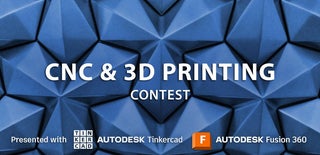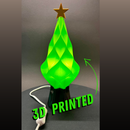Introduction: Motorized IKEA SNUDDA Turntable
This 3D print provides an easy way to add a speed-controllable motor to an IKEA SNUDDA turntable. This allows you to show off artful 3D creations from all sides.
Features:
- Motorization is barely visible (recessed below large disc)
- The turntable is not increased in height
- Can be powered with a standard USB charger (e.g. smartphone charger)
- Uses standardized N20 DC geared motor
The large bevel gear has 140 teeth. The small bevel gear has 7 teeth. Hence the large disc will rotate 20 times slower than the motor shaft. If you buy a DC motor with 50 RPM, the maximum rotation speed of the large disc is 2.5 turns per minute or once every 24 seconds. If you need more speed buy a 100 RPM motor, but you probably want to spin it a lot slower, which is possible by turning the speed knob down.
Credit: Thanks to Svw over at Printables.com for this great 3d model!
Supplies
- IKEA SNUDDA Lazy Susan (900.744.83): IKEA: €7
- DC Geared Motor N20 DC 6V Brush 50 or 100 RPM Electric Micro High Torque: amazon: €9.50 or aliexpress: €1.50
- PWM DC Low Voltage Motor Speed Controller 1803BK: amazon: €8.75 for 2 pcs or aliexpress: €1
- DIY Male Connector MICRO USB to DIP Adapter 2.54mm 5pin: amazon: €5 for 10 pcs or aliexpress: €1 for 10 pcs
- 4x electrical wire in different colors
- 6x wood screws 3 mm x 12 mm (self drilling)
Step 1: Print Instructions
Everything is easy to print in PLA. No supports needed. The color of the printed parts is not really important as they are barely visible in normal viewing conditions.
Bevel Gears (Large and Small)
- 0.10 mm DETAIL profile
Case
- 0.20 mm QUALITY profile
- Avoid any infill in the curved front wall to get a smooth result:
- Vertical shells → Perimeters: 4
- Quality → Ensure vertical shell thickness: OFF
- Quality → Detect thin walls: OFF
Step 2:
The assembly is quite easy if you are (a bit) familiar with a soldering iron. If not, look up some YouTube tutorials. It is not difficult at all.
Here are the different steps for adding the motorization:
- Draw a circle on the bottom of the turntable. This will be used to align the large bevel gear. Note that the small wooden disc is often not round. So you should take a fixed point on the inner disc and rotate the disc with the pencil around to draw the circle. That way the pencil will be at a constant distance from the rotation axis.
Step 3:
Put the 4 parts of the large bevel gear around the inner disc. There are two different types and they should alternate. The parts with the narrow ends go below and the ones with the wider ends must be put on top of them.
Step 4:
- The picture above shows how the pieces fit together (note that the bevel gear is shown upside down here). When the large bevel gear is completed. You must align it on the large disc by keeping a fixed distance to the drawn circle. Then you can screw the large bevel gear on the large disc. The inner screw holes only have to be used if the outer screw holes are not sufficient to fix the large bevel gear firmly in place.
Step 5:
- Push the small bevel gear on the motor shaft (not too far yet, makes it easier to insert the motor)
- Solder 2 wires on USB the connector: black wire on the GND pin and red wire on the VBUS pin. Twist wires together. Make sure the wires are long enough (they can be trimmed to the right length later). Note: The black and red wires are too short in the picture below. I had to redo them.
Step 6:
- Solder 2 wires on the DC motor and twist wires together.
- Insert the motor gently into its holder
Step 7:
- Route motor wires between guides (carefully push 1 wire at a time between guides)
- Insert motor speed controller (shaft first), gently push back side under hooks.
Step 8:
- Put washer and nut on speed controller shaft to fix the controller in place.
Step 9:
- Connect motor wires to the speed controller (see picture). Swapping the wires will reverse the spin direction.
Step 10:
- Insert the USB connector (put the metal connector in the hole first).
- Route USB power wires between guides (carefully push 1 wire at a time between guides)
- Connect the power wires to the motor speed controller as in the picture (and indicated on the shell): The black wire (USB GND) should be connected to the - port (outermost port)
- The red wire (USB VBUS) should be connected to the + port.
- Check these connections carefully! Also, check that the ports on your speed controller are in the same order as mine. Make the necessary adjustments, if this is not the case.
Step 11:
- Push the speed controller knob on its shaft (decide for yourself what the off position should be)
- Put the wedge-shaped case against the inner disc and check that the small bevel gear is aligned with the large bevel gear. Adjust the position of the small bevel gear if needed.
Step 12:
Screw the case onto the bottom part of the turn table. The edge should be aligned with the wooden edge of the small disc. But slight adjustments can still be made later if needed.
Step 13:
- That's all! You can flip your motorized SNUDDA around, connect a USB charger to the connector and turn the speed knob until the disc starts to turn.

Participated in the
CNC and 3D Printing Contest














